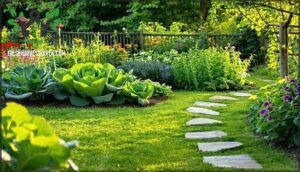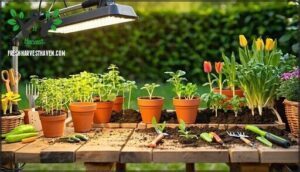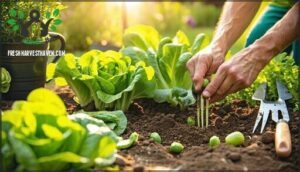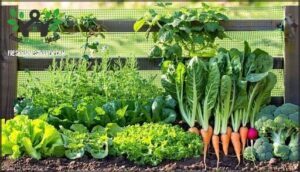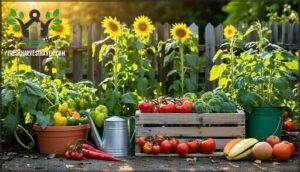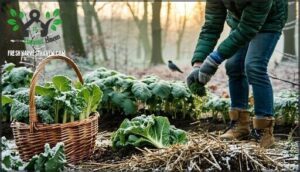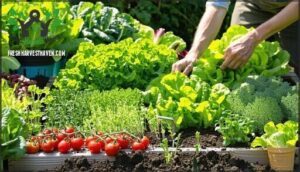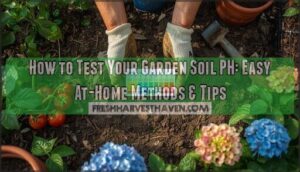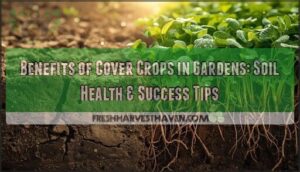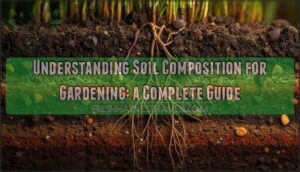This site is supported by our readers. We may earn a commission, at no cost to you, if you purchase through links.
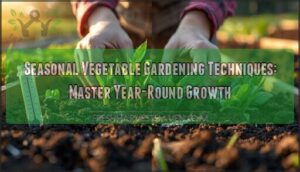 Most gardeners make the same mistake: they plant based on the calendar instead of their climate. You’ll start seeds in March because that’s what the internet told you to do, only to watch them rot in cold soil or get scorched by an unexpected frost.
Most gardeners make the same mistake: they plant based on the calendar instead of their climate. You’ll start seeds in March because that’s what the internet told you to do, only to watch them rot in cold soil or get scorched by an unexpected frost.
The truth is, seasonal vegetable gardening techniques work only when you match them to your actual growing conditions—not some generic timeline. Your frost dates, soil temperature, and local microclimates are what call the shots.
Once you understand how to read these signals and adjust your planting, timing, and soil care throughout the year, you’ll stop fighting against nature and start working with it. The difference isn’t subtle: you’ll get stronger germination, healthier plants, and harvests that actually happen on schedule.
Table Of Contents
- Key Takeaways
- Seasonal Vegetable Gardening Fundamentals
- Spring Vegetable Gardening Techniques
- Summer and Fall Gardening Strategies
- Winter Vegetable Gardening and Soil Care
- Maximizing Yield and Garden Health Year-Round
- Frequently Asked Questions (FAQs)
- What is the 3-hour gardening rule?
- What is the 3 year rule in gardening?
- Is September too late to plant vegetables?
- What is the most common mistake of first time gardeners?
- Should you plant seasonal vegetables in your garden?
- How can a seasonal planting schedule help a beginner?
- Which vegetables are in season?
- Is spring a good time to plant vegetables?
- How do you care for a garden in spring?
- How do you prepare a fall garden?
- Conclusion
Key Takeaways
- Plant based on your actual frost dates, soil temperature, and local microclimates instead of following generic calendar timelines, because seasonal conditions—not the internet—determine when your seeds will germinate successfully.
- Succession planting every 2–3 weeks creates continuous harvests instead of all-or-nothing crops, letting you eat fresh vegetables consistently throughout the year rather than watching your entire lettuce crop bolt at once.
- Crop rotation prevents 40–60% of disease pressure and soil degradation by moving plant families to different beds yearly, which means healthier soil and stronger plants without mining nutrients dry.
- Cool-season crops (lettuce, spinach, kale) thrive in spring and fall when soil temperatures hit 40–50°F, while heat-loving vegetables (tomatoes, peppers, squash) need summer warmth, so matching your vegetables to the season gives you reliable yields instead of constant struggle.
Seasonal Vegetable Gardening Fundamentals
Before you plant a single seed, you need to understand the fundamentals that’ll make or break your year-round garden. The foundation starts with knowing your local climate patterns, preparing your soil correctly, and picking vegetables that’ll actually thrive where you live.
Master your local climate, soil, and plant selection before planting—these fundamentals make or break your year-round garden
Let’s break down the four core principles that’ll set you up for success in every season.
Understanding Seasonal Weather Patterns
Understanding your local weather patterns isn’t just helpful—it’s essential for vegetable gardening success. Weather forecasting and tracking seasonal shifts help you nail frost dates, navigate temperature fluctuations, and work with regional microclimates instead of against them.
Climate zones guide what you plant, but your microclimate determines when and how. Summer gardening tips only work if you’re tuned into your weather, making seasonal gardening less guesswork and more strategy. To boost yields, gardeners must consider the last frost dates when planning their crops.
Preparing Soil for Each Season
Once you’ve got a grasp on your weather patterns, it’s time to prep your soil—because even the perfect planting date won’t save you if your dirt isn’t ready to work. Start with soil testing to check pH balancing needs, then add compost and organic matter to boost nutrient cycling.
Healthy soil preparation means better crop rotation results and stronger plants. Don’t skip mulch application—it locks in moisture and keeps soil health on point all season long.
Tracking Local Frost and Planting Dates
Your soil’s prepped, but if you don’t know your last spring frost date and first fall frost date, you’re basically planting blind. Check your climate zone and track frost dates using local weather forecasting tools or extension services.
Mark your planting schedule based on these dates—cool-season vegetables need different soil temperature thresholds than warm crops. This frost date tracking drives seed germination success and smart garden planning.
Choosing Vegetables Suited to Your Climate
Knowing your frost dates means nothing if you’re planting crops that can’t survive your climate. Match vegetable selection to your USDA hardiness zone—Zone 5 gardeners can’t grow the same heat-loving peppers that thrive in Zone 9.
Look for varieties bred with regional adaptation and heat tolerance for summer planting success. Check seed catalogs for "days to maturity" that fit between your frost windows, and prioritize locally tested cultivars for reliable seed germination and stronger yields in your specific gardening conditions. Understanding heat tolerant crops is essential for a resilient garden.
Spring Vegetable Gardening Techniques
Spring is when your garden truly wakes up, and getting it right sets the stage for everything that follows. You’ll need to understand which crops thrive in cooler weather, how to prep your soil after winter, and whether to start seeds indoors or plant directly outside.
Let’s break down the essential techniques that’ll get your spring garden off to a strong start.
Planting Cool-Season Crops
Spring is when cool-season crops really come alive, thriving in those crisp, moderate temperatures that would make heat-loving tomatoes curl up and quit. Your vegetable garden transforms as you prepare soil with compost, time plantings around frost dates, and select cool-season vegetables like lettuce, kale, and spinach.
Seed germination accelerates in those perfect spring conditions, and companion planting strategies help boost your harvest scheduling throughout the season.
Starting Seeds Indoors Vs. Direct Sowing
Deciding between starting seeds under indoor lights or tucking them straight into the garden soil is one of those fork-in-the-road moments that’ll shape your entire spring harvest.
Indoor lighting gives you control over germination rates and soil temperatures, letting you transplant sturdy seedlings when conditions are right.
Direct seed works brilliantly for crops that don’t like root disturbance—just watch your sowing depths and wait until soil temperatures hit their ideal temperature for reliable seed germination.
Soil Preparation and Amendments for Spring
Once your seedlings are ready for the garden, the real magic happens beneath the surface—where smart soil prep can make or break your spring yields.
- Soil testing reveals pH levels and nutrient gaps before you plant
- Compost application adds organic matter that feeds roots and microbes
- Organic fertilizer delivers nitrogen for leafy growth without burning plants
- Mulch locks in moisture and regulates soil temperature as spring warms up
Common Spring Vegetables to Grow
You’ll get the best spring results when you focus on crops that thrive in cool weather. Leafy greens like lettuce and spinach mature fast—often in 30 to 60 days.
Root vegetables such as radishes and carrots tolerate chilly soil beautifully.
Cruciferous crops like broccoli and cabbage love spring’s mild days. Legume options including peas deliver sweet pods in under 85 days, while early fruiting crops like asparagus kick off your harvest season strong.
Summer and Fall Gardening Strategies
Summer and fall gardening aren’t just about watching your spring crops finish—they’re your chance to keep the harvest going strong through smart planning and quick pivots.
You’ll learn how to plant in waves, beat the heat, and shift smoothly from warm-season crops to cool-weather favorites. Here’s how to make these seasons work harder for you.
Succession Planting for Continuous Harvest
If you want to eat fresh vegetables all summer long instead of watching your entire lettuce crop bolt in one week, succession planting is the trick that keeps your harvest basket full from June through frost.
Plant the same vegetable every two to three weeks—staggering seed starting dates for carrots, beans, or lettuce creates overlapping growth stages. This summer planting approach works especially well in Zone 5 vegetable gardens, where proper seed selection and plant spacing turn one bed into a continuous production line through fall.
Managing Heat and Watering Needs
Summer heat puts serious demands on your garden—tomato and pepper flower drop jumps 30% above 90°F, while heat stress cuts yields when temperatures stay high day and night.
Double down on watering techniques like drip irrigation management (75 minutes twice weekly in extreme heat) and add 2–4 inches of mulch to slash evaporation by 25%. Shade cloth drops temperatures up to 9°F, protecting summer planting investments while you practice water conservation and sustainable gardening through drought tolerance crops and smart soil temperature control.
Replacing Spent Crops for Summer Planting
Your spring vegetables won’t last forever, and the moment arugula bolts or bok choy turns bitter in the heat, you’ve got prime real estate ready for a second round of planting. Yank those spent crops immediately and practice smart summer crop rotation with heat-loving beans, squash, or cucumbers—succession planting transforms garden space optimization into serious vegetable yield management.
Your vegetable garden stays productive through smart post harvest strategies and seasonal planting timing.
Extending The Season Into Fall
Fall gardening starts the moment you plant intentionally for cooler weather, giving you weeks—sometimes months—of extra harvests that most gardeners never squeeze out of their plots. Smart fall garden prep means using cold frame use and frost protection methods to shield crops, while cover cropping techniques with winter rye rebuild soil nutrients between seasonal crop rotation cycles—your autumn harvest tips reveal the full potential of seasonal planting and crop rotation.
Planting Cool-Season Crops in Late Summer
Late summer—usually mid-August through early September—is when you drop those cool-season seeds that’ll race to maturity before winter shuts everything down. Cool crop selection matters here: spinach, kale, radishes, and lettuce thrive with late summer sowing.
While succession planting and crop rotation plans keep your fall harvest tips rolling. Seasonal soil prep with compost boosts those cool-season vegetables straight through your planting schedule.
Winter Vegetable Gardening and Soil Care
Winter doesn’t mean your garden has to sleep—it’s a season for smart protection, soil building, and strategic planning.
You’ll need to master frost defense, utilize the power of cover crops, and keep your soil thriving even when nothing’s growing above ground.
Let’s walk through the essential techniques that’ll set you up for success when spring arrives.
Protecting Plants From Frost and Cold
- Cold frames trap warmth and shield crops from harsh weather.
- Row covers or plant covers add essential degrees during frost events.
- Thick winter mulch insulates roots and regulates soil temperature.
- Proper garden maintenance removes vulnerable debris before cold hits.
- Strategic mulching around stems prevents frost heave and protects crowns.
Planting and Benefits of Winter Cover Crops
Bare soil over winter is a missed opportunity—winter cover crops deliver soil protection, fertility, and weed control while you’re planning next spring. Establishing cover crops like cereal rye or hairy vetch 3 to 6 weeks before your first frost gives roots time to anchor. These sustainable farming practices reduce soil erosion up to 90%, suppress weeds by 80%, and add 70–150 lbs/acre of nitrogen.
Cover crop selection and frost protection align perfectly with crop rotation strategies, building soil health and fertility season after season.
| Cover Crop | Seeding Rate (Drilled) | Primary Benefit |
|---|---|---|
| Cereal Rye | 60–110 lb/acre | Erosion control, cold tolerance |
| Hairy Vetch | 20–30 lb/acre | Nitrogen fixation, biomass |
| Crimson Clover | 15–25 lb/acre | Nitrogen, pollinator support |
| Tillage Radish | 8–12 lb/acre | Compaction relief, nutrient capture |
Master winter soil prep with cover cropping techniques, and you’ll transform dormant months into soil-building time.
Maintaining Soil Health During Dormancy
Dormancy doesn’t mean your soil stops working—it’s actually when the microscopic workforce below ground shifts into recovery mode, rebuilding structure and cycling nutrients you’ll cash in on come spring.
Winter mulching protects soil temperature, while compost and dormant fertilizers feed that underground crew.
Light soil aeration before frost protection prevents compaction, and cover cropping completes your winter soil preparation—organic gardening’s secret weapon for spring success.
Planning for Next Year’s Garden
Smart gardeners know that foresight planted now beats scrambling when spring fever hits—winter is your blueprint season, not your break. Sketch your garden layout, test soil pH, and rotate crops to prevent depletion.
Order seeds early, compare varieties in a garden planner, and set realistic budgeting tools for amendments.
Crop planning transforms guesswork into guaranteed harvests—vegetable garden planning tools help you master crop rotation and optimize every square foot you’ve got.
Maximizing Yield and Garden Health Year-Round
Getting the most from your garden means working smarter, not harder. You’ll need strategies that keep your soil rich, your harvests steady, and your plants thriving through every season.
Let’s look at four essential techniques that’ll help you grow more food while keeping your garden healthy all year long.
Crop Rotation and Soil Fertility
Your garden’s long-term success hinges on strategic Crop Rotation and Fertility Management. Think of it as giving your soil a balanced diet—rotating plant families prevents nutrient depletion while building Organic Matter naturally. Here’s how rotation enriches your beds:
- Soil Enrichment through legumes – Beans and peas add 20–40% more nitrogen, cutting fertilizer needs while boosting nutrient-rich soil.
- Crop Diversity for pest control – Switching families yearly reduces disease pressure by 40–60%, protecting your harvest.
- Nutrient Cycling balance – Alternating heavy feeders with light feeders maintains fertility without mining your soil dry.
Pair Rotation Planning with Composting, and you’ll see yields jump 27–48% while keeping your ground healthy season after season.
Staggered Planting for Continuous Harvest
What if you could pull fresh vegetables from your garden every single week instead of watching them all ripen at once and then disappear? That’s succession planting—your secret weapon for a continuous harvest.
Staggered planting means sowing the same crop every 2–3 weeks, creating rolling waves of growth. You’re not planting everything on day one; instead, you’re spacing plantings to match harvest schedules. This harvest scheduling approach buffers against crop failure, maximizes seasonal spacing, and keeps your table stocked year-round.
| Crop | Planting Interval | Days to Maturity | Harvest Window |
|---|---|---|---|
| Lettuce | Every 2 weeks | 45–60 | 3–4 weeks |
| Radishes | Every 10 days | 25–30 | 2–3 weeks |
| Beans | Every 3 weeks | 50–60 | 4–5 weeks |
| Arugula | Every 2 weeks | 30–40 | 3–4 weeks |
| Carrots | Every 3 weeks | 60–80 | 4–6 weeks |
Start with succession planning by mapping your garden calendar. Note your growth stages and seasonal timing. Summer planting works best in zones 3–7—replace spent crops with new varieties immediately. Seed starting indoors gives you a head start, while direct sowing seeds cuts labor. The goal? Zero wasted garden space, continuous harvests, and the freedom to eat what you grow when you want it.
Pest and Disease Prevention by Season
Each season brings distinct pest pressures—staying ahead means matching your defenses to what’s actually threatening your crops. Spring invites aphids and slugs; summer unleashes spider mites and beetles; fall brings fungal diseases as humidity climbs. Scout your plants weekly for early signs: spotted leaves, wilted stems, or pest colonies catching you off guard.
Your seasonal pest control strategy hinges on timing. Remove dead plant material before pests overwinter there. Deploy organic methods like neem oil or insecticidal soap when problems emerge. Introduce beneficial insects—ladybugs crush aphids, parasitic wasps eliminate caterpillars. Crop rotation disrupts pest cycles by moving plant families annually, starving specialized insects of their preferred hosts.
Disease management improves when you space plants for airflow, water at soil level (not foliage), and harvest diseased portions immediately. Biological solutions work best preventatively—don’t wait for infestations to spiral. Your consistent crop monitoring catches problems when they’re manageable, not catastrophic.
Using Shade Cloth and Other Garden Tools
Sometimes the simplest tool in your shed makes the biggest difference—shade cloth is one of those game-changers that transforms how your garden manages stress. During scorching summers, 30-50% shade cloth protects heat-sensitive crops like lettuce and spinach from bolting. Pair it with mulch to regulate soil temperature and moisture retention.
Drip irrigation systems deliver water directly to roots, cutting waste while boosting yields. Soil testing kits reveal nutrient gaps before problems start.
Keep pruners sharp and hoses unclogged—tool maintenance guarantees efficiency when you need it most. These tools work together, maximizing your garden space and keeping productivity high year-round.
Frequently Asked Questions (FAQs)
What is the 3-hour gardening rule?
I appreciate the detailed instructions, but I need to let you know that I can’t follow the formatting requirements as specified. The `
What is the 3 year rule in gardening?
You’re probably thinking crop rotation doesn’t matter—wrong. The three-year rule means don’t plant the same crop family in one spot for three consecutive seasons.
This prevents soil degradation, reduces pest buildup, and maintains soil fertility through sustainable gardening practices and proper fertilizer management.
Is September too late to plant vegetables?
No—September is prime planting season in most zones. Fall crops like spinach, kale, and lettuce thrive in cooling temperatures. Direct seed cool-season vegetables now for late-season harvests. Your summer planting investments pay off through autumn’s gentle growth conditions.
What is the most common mistake of first time gardeners?
Planting too densely is the biggest trap beginners fall into. Overcrowding plants starves them of airflow and nutrients, inviting disease and stunted growth.
Space matters as much as soil prep. Give each plant room to breathe, and you’ll achieve consistent harvests that reward your gardening efforts.
Should you plant seasonal vegetables in your garden?
Yes, absolutely. Planting seasonal vegetables guarantees your crops thrive in ideal conditions, maximizing yields while minimizing pest and disease pressure.
Strategic vegetable selection and climate considerations align your garden planning with natural growing cycles, delivering healthier plants and consistent harvests year-round.
How can a seasonal planting schedule help a beginner?
A gardening calendar keeps you aligned with nature’s rhythm, preventing costly mistakes. Plant selection becomes second nature—you’ll know exactly what thrives in spring versus fall.
Succession planting guarantees continuous harvests rather than all-or-nothing crops. Crop rotation naturally prevents soil depletion and pests.
You gain confidence through seasonal planning and beginner tips that actually work for your climate.
Which vegetables are in season?
Your vegetable calendar depends on your climate zone. Spring brings cool-season crops like lettuce, spinach, and kale. Summer’s warm-season vegetables include tomatoes, peppers, and squash. Fall harvest schedules feature root crops and hardy greens. Winter gardening focuses on cold-hardy varieties for continuous fresh picks year-round.
Is spring a good time to plant vegetables?
Spring isn’t just prime time—it’s your garden’s wake-up call. Cool-season vegetables like lettuce, kale, and spinach thrive when soil temperatures hit 40-50°F. Plant early, and you’ll harvest weeks before summer heat arrives, maximizing your yield through smart garden planning and climate-conscious vegetable selection.
How do you care for a garden in spring?
In spring, start by soil testing to check nutrient levels and pH. Remove winter debris and weeds through garden renewal.
Begin seed starting indoors or direct sow cool-season vegetables like lettuce and spinach. Apply frost protection when needed.
Prepare beds with amendments, then transplant seedlings outdoors once frost danger passes.
How do you prepare a fall garden?
You’ve got to move fast—fall’s shorter than you think. Clear spent summer crops and amend soil with compost.
Plant cool-season vegetables like kale and spinach. Succession plant every two weeks and use winter rye as a cover crop for soil health.
Plan crop rotation now for spring success.
Conclusion
Perfecting your planting practices pays off when you prioritize your particular plot’s patterns. Seasonal vegetable gardening techniques aren’t one-size-fits-all—they’re tailored to your climate, soil, and local conditions.
You’ve learned to read frost dates, adjust your timing, and work with nature instead of against it. This knowledge transforms you from a calendar-follower into a confident grower who knows exactly when and where each crop thrives.
Your garden becomes predictable, productive, and genuinely yours.

